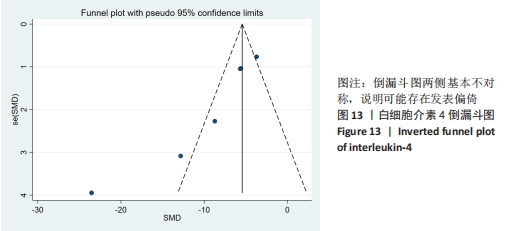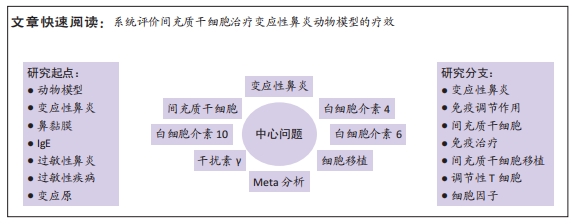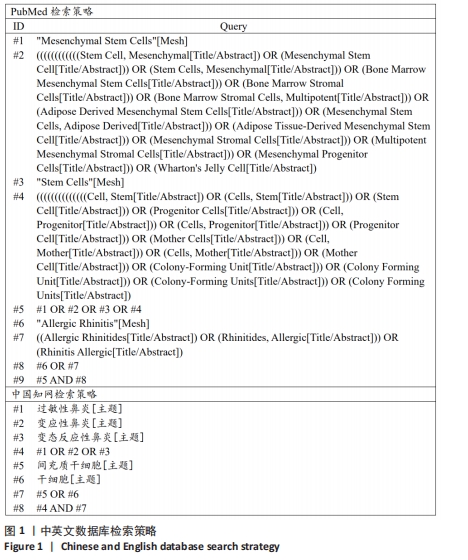2.1 文献检索结果 2名研究人员通过对中英文数据检索,初步检索到380篇文献。通过去除重复文献得到305篇,通过初筛和复筛去除299篇,最终纳入6篇文献[15-20],流程图见图2。

2.2 纳入文献的基本特征 纳入6篇文献,共152只小鼠,其中干细胞组小鼠51只,空白对照组小鼠51只,动物模型对照组小鼠50只,其中4篇期刊文章[16-18,20],1篇硕士毕业论文[19],1篇博士毕业论文[15];其中有2篇所用干细胞为骨髓来源间充质干细胞[15,18],1 篇所用干细胞为人脐带间充质干细胞[19],3篇所用干细胞为脂肪来源间充质干细胞[16-17,20]。5篇研究对象为BALB/c小鼠[15-16,18-20],1篇研究对象为KM小鼠[17]。纳入文献的基本特征见表1。

2.3 纳入文献的质量评价 根据SYRCLE动物实验偏倚风险评估量表对纳入文献进行质量评价,总体为中等质量研究,见表2。

2.4 Meta分析结果
2.4.1 变应性鼻炎症状 总共有5篇文献提到了过敏性鼻炎的症状[15-16,18-20],其中3篇分别提到了喷嚏次数和揉鼻次数[15,18,20],其中干细胞组小鼠21只,动物模型对照组小鼠20只,对各研究进行异质性检验,I2=93.7%,故采用随机效应模型进行Meta分析,喷嚏次数亚组结果提示:干细胞组的喷嚏次数明显少于动物模型对照组,且差异有显著性意义[SMD=-9.83,95%CI(-17.45,-2.22),P=0.011],揉鼻次数亚组结果显示:干细胞组的揉鼻次数明显少于动物模型对照组,差异有显著性意义[SMD=-13.27,95%CI(-25.04,-1.49),P=0.027],见图3。

2.4.2 白细胞介素4水平
干细胞组vs.动物模型对照组:6篇文献提到了血清白细胞介素4水平[15-20],其中有3篇提到了脾脏白细胞介素4水平[16- 17,19],干细胞组小鼠51只,动物模型对照组小鼠50只,对各研究进行异质性检验,I2=94.6%,故采用随机效应模型进行Meta分析,在血清白细胞介素4水平亚组中分析结果显示:干细胞组的白细胞介素4水平明显低于动物模型对照组,差异有显著性意义[SMD=-8.23,95%CI(-11.28,-5.17),P=0],脾脏白细胞介素4水平分析结果显示:白细胞介素4水平在干细胞组与动物模型对照组之间并没有明显差异[SMD=-17.33,95%CI(-36.85,2.20),P=0.082],见图4。

干细胞组vs.空白对照组:6篇文献提到了血清白细胞介素4水平[15-20],其中有3篇提到了脾脏白细胞介素4水平[16-17,19],干细胞组小鼠51只,动物模型对照组小鼠50只,对各研究进行异质性检验,I2=94.8%,故采用随机效应模型进行Meta分析,血清白细胞介素4水平亚组分析结果显示:白细胞介素4水平在干细胞组与空白对照组之间并没有明显差异[SMD=1.26,95%CI(-0.42,2.94),P=0.142],脾脏白细胞介素4水平亚组分析结果显示:白细胞介素4水平在干细胞组与空白对照组之间并没有明显差异[SMD=-1.17,95%CI(-10.94,8.60),P=0.815],见图5。

2.4.3 干扰素γ水平
干细胞vs.动物模型对照组:共有3篇文献提到了干扰素γ水平[16-17,19],这3篇文章均提到了血清中与脾脏中的干扰素γ水平,其中干细胞组小鼠30只,动物模型对照组小鼠30只。对各研究进行异质性检验,I2=94.9%,故采用随机效应模型进行Meta分析,血清干扰素γ水平亚组分析结果显示:干细胞组与动物模型对照组无明显差异[SMD=6.98,95%CI(-14.19,28.15),P=0.518],脾脏干扰素γ水平亚组分析结果显示:干细胞组与动物模型对照组无明显差异[SMD=11.27,95%CI(-5.86,28.41),P=0.197],见图6。

干细胞组vs.空白对照组:共有3篇文献提到了干扰素γ水平[16- 17,19],这3篇文章均提到了血清中与脾脏中的干扰素γ水平,其中干细胞组小鼠30只,空白对照组小鼠30只。对各研究进行异质性检验,I2=84.2%,故采用随机效应模型进行Meta分析,血清干扰素γ水平亚组分析结果显示:干细胞组与空白对照组无明显差异[SMD=0.15,95%CI(-1.03,1.33),P=0.803],脾脏干扰素γ水平亚组分析结果显示:干细胞组的干扰素γ水平亚组明显高于空白对照组 [SMD=2.06,95%CI(1.22,2.90),P=0],见图7。
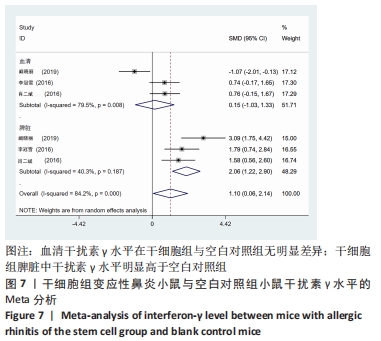
2.4.4 白细胞介素6水平
干细胞组vs.动物模型对照组:共有2篇文献提到了白细胞介素6水平[16-17],这2篇中均提到了血清中与脾脏中的白细胞介素6水平,其中干细胞组小鼠20只,动物模型对照组小鼠20只。对各研究进行异质性检验,I2=94.3%,故采用随机效应模型进行Meta分析。血清白细胞介素6亚组分析结果显示:干细胞组白细胞介素6水平明显低于动物模型对照组,且差异有显著性意义[SMD=-4.27,95%CI (-5.43,-3.10),P=0.035],脾脏白细胞介素6亚组分析结果显示:干细胞组白细胞介素6水平低于动物模型对照组[SMD=
-40.64,95%CI(-80.16,-1.13),P=0],见图8。

干细胞组vs.空白对照组:共有2篇文献提到了白细胞介素6水平[16-17],这2篇中均提到了血清中与脾脏中的白细胞介素6水平,其中干细胞组小鼠20只,空白对照组小鼠20只。对各研究进行异质性检验,I2=6.1%,故采用固定效应模型进行Meta分析。血清白细胞介素6亚组分析结果显示:干细胞组白细胞介素6水平明显低于空白对照组,且差异有显著性意义[SMD=-1.88,95%CI(-2.64,-1.12),P=0],脾脏白细胞介素6亚组分析结果显示:干细胞组白细胞介素6水平明显低于空白对照组,且差异有显著性意义[SMD=-1.07,95%CI(-1.74,-0.40),P=0.002],见图9。

2.4.5 白细胞介素10水平
干细胞组vs.动物模型对照组:共有3篇文献提到了血清白细胞介素10水平[15-17],其中2篇提到了脾脏白细胞介素10水平[16-17],干细胞组小鼠30只,动物模型对照组小鼠30只,对各研究进行异质性检验,I2=96.3%,故采用随机效应模型进行Meta分析,血清白细胞介素10水平亚组分析结果显示:干细胞组与动物模型对照组之间无明显差异[SMD=1.13,95%CI(-14.30,16.56),P=0.886],脾脏白细胞介素10水平亚组分析结果显示:干细胞组脾脏白细胞介素10水平明显高于动物模型对照组[SMD=25.63,95%CI(17.92,33.33),P=0],见图10。
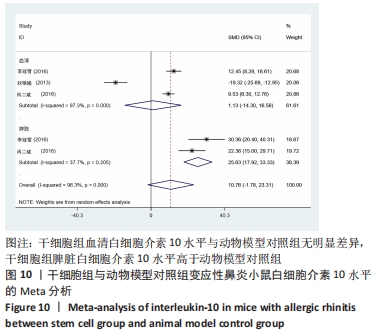
干细胞vs.空白对照组:共有3篇文献提到了血清白细胞介素10水平[15-17],其中2篇提到了脾脏白细胞介素10水 平[16-17],干细胞组小鼠30只,空白对照组小鼠30只,对各研究进行异质性检验,I2=97.3%,故采用随机效应模型进行Meta分析,血清白细胞介素10水平亚组分析结果显示:干细胞组与空白对照组之间无明显差异[SMD=6.60,95%CI(-3.23,16.43),P=0.188],脾脏白细胞介素10水平亚组分析结果显示:干细胞组脾脏白细胞介素10水平明显高于空白对照组[SMD=25.63,95%CI(17.92,33.33),P=0],见图11。

2.4.6 亚组分析 对血清学白细胞介素4指标基于干细胞不同的来源、小鼠的类型、注射方式进行亚组分析。
干细胞类型:骨髓来源间充质干细胞组血清白细胞介素4水平与空白对照组未见明显差异[SMD=91.3,95%CI(-0.76,10.64),P=0.091];人脐带间充质干细胞组血清白细胞介素4水平较空白对照组明显降低[SMD=-1.93,95%CI(-3.04,-0.83),P=0.001];脂肪来源间充质干细胞组血清白细胞介素4水平较空白对照组无明显差异[SMD=0.21,95%CI(-0.40,0.82) P=0.503],干细胞与动物模型组比较见表3。

小鼠类型:干细胞组BALB/c类型小鼠血清白细胞介素4水平与空白对照组未见明显的差异[SMD=-3.13,95%CI(-6.86,0.61),P=0.101];干细胞组KM类型小鼠血清白细胞介素4水平较空白对照组明显降低[SMD=-3.40,95%CI(-4.82,-1.99),P=0],干细胞与动物模型组比较见表3。
注射方式:经尾静脉注射干细胞组白细胞介素4水平明显高于空白对照组[SMD=2.44,95%CI(0.11,4.77),P=0.040];经腹腔注射干细胞组白细胞介素4水平与空白对照组无明显差异[SMD=-0.94,95%CI(-2.82,0.93),P=0.325],干细胞与动物模型组比较见表3。
2.5 敏感性分析 采用stata15.0软件对白细胞介素4逐一去除文献进行敏感性分析,当去除阚晓丽[19]文献时发现合并效应量的圈并不在两边线内,表明血清白细胞介素4的分析结果异质性可能来源于阚晓丽[19]的文献,见图12。

2.6 发表偏倚 通过对白细胞介素4指标绘制倒漏斗图发现两边并非对称,说明可能存在发表偏倚,见图13。
